Micromechanical Properties and Tribological Performance of Mo, Cr, and Ta Coatings Obtained by Cathodic Arc-Deposition
Abstract
1. Introduction
2. Materials and Methods
2.1. Micromechanical Characterization
2.2. Sclerometry Testing
- Mean residual scratch depth after the first pass h1 can characterize the average hardness along the scratch path, and its dispersion dh1 is the hardness variation. To eliminate the influence of initial surface relief, the profilogram of the original surface h0 was subtracted from the registered scratch depth h1. The scratch hardness was calculated using the formula Hs = 3.138R/b2, where the scratch width is b = 7.53 × h1 from geometric considerations for the Berkovich indenter.
- The dependence of the mean residual scratch depth on the number of repeated passes can characterize the scratch resistance or wear resistance of a material.
- The ratio of the increase in the mean value of a residual scratch depth to the mean depth of the first pass can characterize the material plasticity. The dimensionless coefficient can be used as a plasticity indicator: kpl = (hi − h1)/h1.
- The correlation relationship r1 between the profilogram of the initial surface h0 and subsequent residual scratch depth profilograms hi, recorded for each pass, can characterize the resistance to a fatigue failure.
- The correlation relationship r2 between the profilograms of adjacent passes, e.g., (h1 and h2), (h2 and h3), etc., can characterize the strain hardening tendency.
2.3. Microtribological Characterization
3. Results and Discussion
4. Conclusions
- A new scratch test technique based on the statistical processing of registered sclerograms during a multi-pass scratch test well adapted for the mechanical characterization of rough surfaces is proposed. Statistical analysis of the obtained results could provide additional information regarding the micromechanical properties of materials, such as plasticity, resistance to fatigue failure, and strain-hardening ability.
- A novel approach to microtribological testing on the base of the indentation tester equipped with an additional precision rotational stage is proposed, which could pave the gap between macro- and nanoscale and significantly expand the functionality of the indentation testers.
- The abovementioned methods were used to characterize the chromium, molybdenum, and tantalum coatings produced by vacuum arc deposition. The surfaces of the chromium and molybdenum arc-deposited coatings are observed to be much rougher (maximum values reaching Ra = 0.9 µm) and characterized by a high roughness anisotropy. Conversely, the surface of the tantalum arc-deposited coating is much smoother (Ra = 0.2 µm).
- As observed, the arc-deposited coatings possess a higher hardness and reduced elastic modulus than the same materials produced by casting. These features relate to the observed formation of nanoscale grains, crystallographic anisotropy, and compressive stresses.
- Mechanical characterization of deposited coating using depth-sensing indentation and multi-pass scratch tests shows that Mo coating has the highest indentation and scratch hardness (HIt = 4.2 GPa and Hs = 4.3 GPa) and elastic modulus (E = 285 GPa). It has better scratch resistance but lower micro-fatigue resistance and strain-hardening tendency than Cr coating. Ta coating has the lowest values of indentation hardness (HIt = 3.4 GPa) and elastic modulus (E = 171 GPa) and is subjected to severe adhesive wear with material transfer during multi-pass scratch testing despite the lower surface roughness (Ra = 01–02 µm).
- The microtribological test of the coatings obtained by vacuum-arc deposition showed different microtribological behavior. The tantalum coating has the lowest wear resistance and highest friction coefficient (0.6) among tested coatings; the volume of worn material is the largest and equal to VTa = 172 × 106 µm3. The surface topography analysis showed adhesive wear of the coating accompanied by sticking and transfer of material along the track path. This is also confirmed by the multi-pass scratch test results; a correlation between the first and further recorded profilograms is absent, and the scratch profiles change dramatically after each pass. This can be explained by the fact that tantalum has a strong adhesive interaction with the indenter material. Coatings from molybdenum and chromium have a low coefficient of friction (kfr = 0.08 and 0.09, respectively) and show a good scratch resistance and wear performance, which are in a good correlation with their mechanical properties.
Author Contributions
Funding
Institutional Review Board Statement
Informed Consent Statement
Data Availability Statement
Acknowledgments
Conflicts of Interest
References
- Klesnil, M.; Lukás, P. Fatigue of Metallic Materials, 2nd ed.; Elsevier: Amsterdam, The Netherlands, 1992. [Google Scholar]
- Cooper, D.R.; Skelton, A.C.H.; Moynihan, M.C.; Allwood, J.M. Component level strategies for exploiting the lifespan of steel in products. Resourc. Conserv. Recycl. 2014, 84, 24–34. [Google Scholar] [CrossRef]
- Kodur, V.K.; Aziz, E.M.; Naser, M.Z. Strategies for enhancing fire performance of steel bridges. Eng. Struct. 2017, 131, 446–458. [Google Scholar] [CrossRef]
- Sun, Y.; Bailey, R. Improvement in tribocorrosion behavior of 304 stainless steel by surface mechanical attrition treatment. Surf. Coat. Technol. 2014, 253, 284–291. [Google Scholar] [CrossRef]
- Lu, K.; Lu, J. Nanostructured surface layer on metallic materials induced by surface mechanical attrition treatment. Mater. Sci. Eng. A 2004, 375–377, 38–45. [Google Scholar] [CrossRef]
- Gill, A.S.; Kumar, S. Surface alloying of H11 die steel by tungsten using EDM process. Int. J. Adv. Manuf. Technol. 2015, 78, 1585–1593. [Google Scholar] [CrossRef]
- Mordyuk, B.N.; Prokopenko, G.I.; Volosevych, P.Y.; Matokhnyuk, L.E.; Byalonovich, A.V.; Popova, T.V. Improved fatigue behavior of low-carbon steel 20GL by applying ultrasonic impact treatment combined with the electric discharge surface alloying. Mater. Sci. Eng. A 2016, 659, 119–129. [Google Scholar] [CrossRef]
- Gladczuk, L.; Patel, A.; Paur, C.S.; Sosnowski, M. Tantalum films for protective coatings of steel. Thin Solid Films 2004, 467, 150–157. [Google Scholar] [CrossRef]
- Mordyuk, B.N.; Prokopenko, G.I.; Grinkevych, K.E.; Piskun, N.A.; Popova, T.V. Effects of ultrasonic impact treatment combined with the electric discharge surface alloying by molybdenum on the surface related properties of low-carbon steel G21Mn5. Surf. Coat. Technol. 2017, 309, 969–979. [Google Scholar] [CrossRef]
- Dittrick, S.; Balla, V.K.; Bose, S.; Bandyopadhyay, A. Wear performance of laser processed tantalum coatings. Mater. Sci. Eng. 2011, 31, 1832–1835. [Google Scholar] [CrossRef]
- Kou, Q.; Jin, W.; Ge, C.; Pang, J.; Zhang, J.; Haarberg, G.M.; Xiao, S.; Wang, P. Preparation of molybdenum coatings by molten salt electrodeposition in Na3AlF6-NaF-Al2O3-MoO3 system. Coatings 2023, 13, 1266. [Google Scholar] [CrossRef]
- Broitman, E.; Jahagirdar, A.; Rahimi, E.; Meeuwenoord, R.; Mol, J.M.C. Microstructural, nanomechanical, and tribological properties of thin dense chromium coatings. Coatings 2024, 14, 1597. [Google Scholar] [CrossRef]
- Moreira, H.; Costa-Barbosa, A.; Marques, S.M.; Sampaio, P.; Carvalho, S. Evaluation of cell activation promoted by tantalum and tantalum oxide coatings deposited by reactive DC magnetron sputtering. Surf. Coat. Technol. 2017, 330, 260–269. [Google Scholar] [CrossRef]
- Perepl’otchikov, E.F.; Vasyliv, K.B.; Vynar, V.A.; Zakiev, V.I. Elevation of the Wear Resistance of Low-Alloy Structural Steel by Plasma-Powder Surfacing with Alloys Based on Iron, Chromium, and Nickel. Mater. Sci. 2018, 54, 378–386. [Google Scholar] [CrossRef]
- Nascimento, M.P.; Souza, R.C.; Pigatin, W.L.; Voorwald, H.J.C. Effects of surface treatments on the fatigue strength of AISI 4340 aeronautical steel. Int. J. Fatigue 2001, 23, 607–618. [Google Scholar] [CrossRef]
- Gao, Y.; Li, X.; Yang, Q.; Yao, M. Influence of surface integrity on fatigue strength of 40CrNi2Si2MoVA steel. Mater. Lett. 2007, 61, 466–469. [Google Scholar] [CrossRef]
- Aubert, A.; Gillet, R.; Gaucher, A.; Terrat, J.P. Hard chrome coatings deposited by vapour deposition. Thin Solid Films 1983, 108, 165–172. [Google Scholar] [CrossRef]
- Nascimento, M.P.; Souza, R.C.; Miguel, I.M.; Pigatin, W.L.; Voorwald, H.J.C. Effects of tungsten carbide thermal spray coating by HP–HVOF and hard chromium electroplating on AISI 4340 high strength steel. Surf. Coat. Technol. 2001, 138, 113–124. [Google Scholar] [CrossRef]
- Michailidis, N.; Stergioudi, F.; Maliaris, G.; Tsouknidas, A. Influence of galvanization on the corrosion fatigue performance of high-strength steel. Surf. Coat. Technol. 2014, 259, 456–464. [Google Scholar] [CrossRef]
- Korzynski, M.; Pacana, A.; Cwanek, J. Fatigue strength of chromium coated elements and possibility of its improvement with slide diamond burnishing. Surf. Coat. Technol. 2009, 203, 1670–1676. [Google Scholar] [CrossRef]
- Cohen, M.D.; Kargacin, B.; Klein, C.B.; Costa, M. Mechanisms of chromium carcinogenicity and toxicity. Crit. Rev. Toxicol. 1993, 23, 255–281. [Google Scholar] [CrossRef]
- Efremenko, V.G.; Lekatou, A.G.; Chabak, Y.G.; Efremenko, B.V.; Petryshynets, I.; Zurnadzhy, V.I.; Emmanouilidou, S.; Vojtko, M. Micromechanical, corrosion and wet sliding wear behaviours of Co-28Cr-6Mo alloy: Wrought vs. LPBF. Mater. Today Commun. 2023, 35, 105936. [Google Scholar] [CrossRef]
- Oehlerking, F.; Stawovy, M.T.; Ohm, S.; Imandoust, A. Microstructural characterization and mechanical properties of additively manufactured molybdenum and molybdenum alloys. Int. J. Refract. Met. Hard Mater. 2022, 109, 105971. [Google Scholar] [CrossRef]
- Balla, V.K.; Bodhak, S.; Bose, S.; Bandyopadhyay, A. Porous tantalum structures for bone implants: Fabrication, mechanical and in vitro biological properties. Acta Biomater. 2010, 6, 3349–3359. [Google Scholar] [CrossRef] [PubMed]
- Dong, C.; Bi, X.L.; Yu, J.G.; Liu, R.; Zhang, Q.X. Microstructural evolution and sintering kinetics during spark plasma sintering of pure tantalum powder. J. Alloys Comp. 2019, 781, 84–92. [Google Scholar] [CrossRef]
- Kaserer, L.; Braun, J.; Stajkovic, J.; Leitz, K.-H.; Tabernig, B.; Singer, P.; Letofsky-Papst, I.; Kestler, H.; Leichtfried, G. Fully dense and crack free molybdenum manufactured by selective laser melting through alloying with carbon. Int. J. Refract. Met. Hard Mater. 2019, 84, 105000. [Google Scholar] [CrossRef]
- Ma, S.Q.; Zhao, B.; Pan, S.H.; Shen, X.H.; Yin, Y.G. Quantify strengthening and weakening factors in molybdenum fabricated by laser powder bed fusion (LPBF) with a revisit of its oxygen sensitivity. Mater. Sci. Eng. A 2025, 925, 147856. [Google Scholar] [CrossRef]
- Coelho, G.C.; Costa Neto, J.G.; Gama, S.; Ribeiro, C.-A. Experimental Study of the Iron-Tantalum Equilibrium Diagram. J. Phase Equilibria 1995, 16, 121–128. [Google Scholar] [CrossRef]
- Ding, N.; Wang, T.L.; Tai, K.P.; Li, J.H.; He, X.; Dai, Y.; Liu, B.X. Structural phase transition in the Fe–Ta system studied by ion beam mixing. J. Alloys Compd. 2009, 476, 253–256. [Google Scholar] [CrossRef]
- Lin, C.; Yang, G.W.; Liu, J.B.; Liu, B.X. Metastable crystalline phases formed in the Fe–Ta system by solid-state reaction. J. Alloys Compd. 1999, 288, 159–163. [Google Scholar] [CrossRef]
- Guillermet, A.F. The Fe-Mo (Iron-Molybdenum) System. Bull. Alloy Phase Diagr. 1982, 3, 359–367. [Google Scholar] [CrossRef]
- Higashi, K.; Fukushima, H.; Sakaguchi, S. Phase structure of electrodeposited Fe-Mo Alloys from aqueous solution. Nippon Tungsten Rev. 1977, 10, 74–82. [Google Scholar]
- Dutta Majumdar, J.; Manna, I. Laser surface alloying of AISI 304-stainless steel with molybdenum for improvement in pitting and erosion–corrosion resistance. Mater. Sci. Eng. A 1999, 267, 50–59. [Google Scholar] [CrossRef]
- Murakami, T.; Sasaki, S. Microstructure and tribological properties of Fe-Mo alloy-coated steel specimens prepared by low-pressure plasma spraying. Intermetallics 2011, 19, 1873–1877. [Google Scholar] [CrossRef]
- Li, Z.G.; Su, Y.N.; Liu, X.P.; Xu, Z. Determination of diffusivity on W and Mo in double glow discharge. Acta Met. Sinica 1995, 8, 145–148. [Google Scholar]
- Wang, X.H.; Han, F.; Liu, X.M.; Qu, S.Y.; Zou, Z.D. Effect of molybdenum on the microstructure and wear resistance of Fe-based hardfacing coatings. Mater. Sci. Eng. A 2008, 489, 193–200. [Google Scholar] [CrossRef]
- Murakami, T.; Kaneda, K.; Nakano, M.; Xia, Y.; Sasaki, S. Tribological properties of Fe7Mo6-based-alloy lubricated with poly-alpha-olefin containing PN additive. Tribol. Int. 2010, 43, 312–319. [Google Scholar] [CrossRef]
- Murakami, T.; Mano, H.; Hibi, Y.; Sasaki, S. Friction and wear properties of Fe7Mo6-based alloy in ethyl alcohol. Tribol. Int. 2010, 43, 2183–2189. [Google Scholar] [CrossRef]
- Martin, P.J.; Bendavid, A. Review of the filtered vacuum arc process and materials deposition. Thin Solid Films 2001, 394, 1–14. [Google Scholar] [CrossRef]
- Turley, D.M. Erosion of a chromium-plated tank gun barrel. Wear 1989, 131, 135–150. [Google Scholar] [CrossRef]
- Mattox, D.M. Handbook of Physical Vapor Deposition (PVD) Processing, 2nd ed.; Elsevier: Amsterdam, The Netherlands, 2010; 944p. [Google Scholar]
- Efremenko, B.V.; Shimizu, K.; Espallargas, N.; Efremenko, V.G.; Kusumoto, K.; Chabak, Y.G.; Belik, A.G.; Chigarev, V.V.; Zurnadzhy, V.I. High-temperature solid particle erosion of Cr–Ni–Fe–C arc cladded coatings. Wear 2020, 460–461, 203439. [Google Scholar] [CrossRef]
- Lozynskyi, V.; Trembach, B.; Hossain, M.M.; Kabir, M.H.; Silchenko, Y.; Krbata, M.; Sadovyi, K.; Kolomiitse, O.; Ropyak, L. Prediction of phase composition and mechanical properties Fe–Cr–C–B–Ti–Cu hardfacing alloys: Modeling and experimental Validations. Heliyon 2024, 10, e25199. [Google Scholar] [CrossRef] [PubMed]
- Holmberg, K.; Matthews, A. Coating Tribology: Properties, Mechanisms, Techniques and Applications in Surface Engineering; Tribology and Interface Engineering Series; Elsevier: Amsterdam, The Netherlands, 2009; 576p. [Google Scholar]
- Efremenko, V.G.; Chabak, Y.G.; Fedun, V.I.; Shimizu, K.; Pastukhova, T.V.; Petryshynets, I.; Zusin, A.M.; Kudinova, E.V.; Efremenko, B.V. Formation mechanism, microstructural features and dry-sliding behaviour of “Bronze/WC carbide” composite synthesised by atmospheric pulsed-plasma deposition. Vacuum 2021, 185, 110031. [Google Scholar] [CrossRef]
- Beake, B.D.; Harris, A.J.; Liskiewicz, T.W. Review of recent progress in nanoscratch testing. Tribol.-Mater. Surf. Interfaces 2013, 7, 87–96. [Google Scholar] [CrossRef]
- Velkavrh, I.; Lüchinger, M.; Kern, K.; Klien, S.; Ausserer, F.; Voyer, J.; Diem, A.; Schreiner, M.; Tillmann, W. Using a standard pin-on-disc tribometer to analyse friction in a metal forming process. Tribol. Int. 2017, 114, 418–428. [Google Scholar] [CrossRef]
- Randall, N.X. The current state-of-the-art in scratch testing of coated systems. Surf. Coat. Technol. 2019, 380, 125092. [Google Scholar] [CrossRef]
- Taylor, A. X-Ray Metallography; John Wiley & Sons: New York, NY, USA; London, UK, 1964. [Google Scholar]
- Lindforfs, P.A.; Mularie, W.M.; Wehner, G.K. Cathodic arc deposition technology. Surf. Coat. Technol. 1987, 29, 275–290. [Google Scholar] [CrossRef]
- Vasylyev, M.A.; Mordyuk, B.N.; Sidorenko, S.I.; Voloshko, S.M.; Burmak, A.P.; Kruhlov, I.O.; Zakiev, V.I. Characterization of ZrN coating low-temperature deposited on the preliminary Ar+ ions treated 2024 Al-alloy. Surf. Coat. Technol. 2019, 361, 414–424. [Google Scholar] [CrossRef]
- Zakiev, I.; Gogotsi, G.A.; Storchak, M.; Zakiev, V. Glass Fracture during Micro-Scratching. Surfaces 2020, 3, 211–224. [Google Scholar] [CrossRef]
- Zakiev, I.; Storchak, M.; Gogotsi, G.A.; Zakiev, V.; Kokoieva, Y. Instrumented indentation study of materials edge chipping. Ceram. Int. 2021, 47, 29638–29645. [Google Scholar] [CrossRef]
- Storchak, M.; Zakiev, I.; Zakiev, V.; Manokhin, A. Coatings strength evaluation of cutting inserts using advanced multi-pass scratch method. Measurement 2022, 191, 110745. [Google Scholar] [CrossRef]
- Firstov, S.A.; Ignatovich, S.R.; Zakiev, I.M. Size effect in the micro- and nanoindentation and its compensation with regard for the specific features of initial contact. Strength Mater. 2009, 41, 147–155. [Google Scholar] [CrossRef]
- Oliver, W.C.; Pharr, G.M. An improved technique for determining hardness and elastic modulus using load and displacement sensing indentation experiments. Mater. Res. 1992, 7, 1564–1583. [Google Scholar] [CrossRef]
- ISO/FDIS 14577-1: 2002; Metallic Materials—Instrumented Indentation Test for Hardness and Materials Parameters. Part 1: Test Method. ISO Central Secretariat: Geneva, Switzerland, 2002.
- Huang, R.Z.; Xie, H.Q.; Guo, L.; Cai, X.; Yang, X.J.; Wei, K. High cycle fatigue behavior and strengthening mechanisms of laser powder bed fusion pure tantalum. Int. J. Fatigue 2025, 190, 108624. [Google Scholar] [CrossRef]
- Duan, F.H.; Naunheim, Y.; Schuh, C.A.; Li, Y. Breakdown of the Hall-Petch relationship in extremely fine nanograined body-centered cubic Mo alloys. Acta Mater. 2021, 213, 116950. [Google Scholar] [CrossRef]
- Darling, K.A.; Hornbuckle, B.C.; Marvel, C.J.; Hammond, V.H.; Solanki, K. Effect of constrained inter-granular regions on the inverse Hall-petch phenomena. Mater. Sci. Eng. A 2023, 875, 145125. [Google Scholar] [CrossRef]
- Liu, X.; Aarts, J.M.; Ma, S.; Choi, J.J.E. The Influence of Polishing on the Mechanical Properties of Zirconia—A Systematic Review. Oral 2023, 3, 101–122. [Google Scholar] [CrossRef]
- Gorban, V.F.; Zakiev, I.M.; Kurilenko, D.V. Mechanical Characteristics of High-Entropy Alloys and Their Constituent Metals in Friction Conditions at Low Sliding Velocities. Powder Metall Met. Ceram. 2019, 58, 265–269. [Google Scholar] [CrossRef]
- Fischer, A.; Dudzinski, W.; Gleising, B.; Stemmer, P. Analyzing Mild- and Ultra-Mild Sliding Wear of Metallic Materials by Transmission Electron Microscopy. In Advanced Analytical Methods in Tribology; Dienwiebel, M., De Barros Bouchet, M.I., Eds.; Microtechnology and MEMS; Springer: Cham, Switzerland, 2018. [Google Scholar] [CrossRef]
- Mordyuk, B.N.; Voloshko, S.M.; Zakiev, V.I.; Burmak, A.P.; Skoryk, M.A.; Mohylko, V.V.; Khripta, N.I.; Malinin, V.Y.; Lesyk, D.A. Wear and Friction Performance of Alumina-Reinforced Composite Coating on Ti-6Al-4V Alloy Produced by Combining Ultrasonic Impact Treatment and Air-Oxidation. J. Mater. Eng. Perform. 2024. [Google Scholar] [CrossRef]
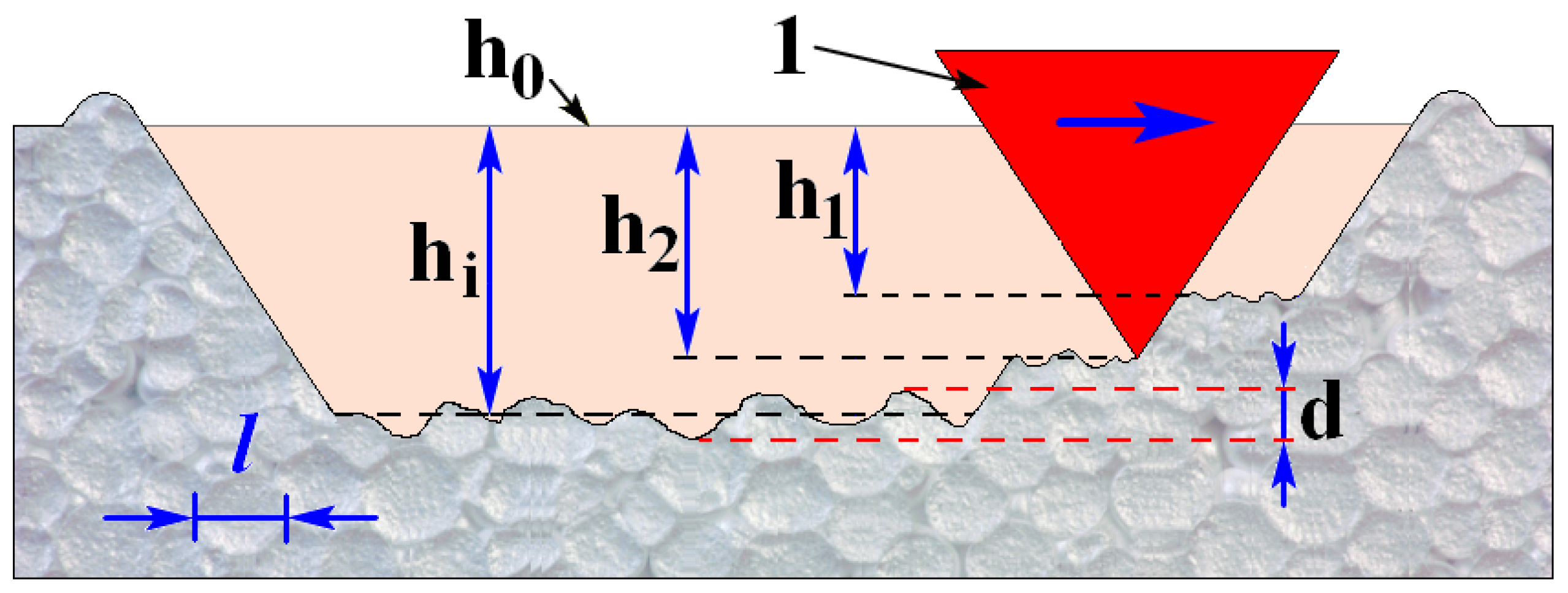
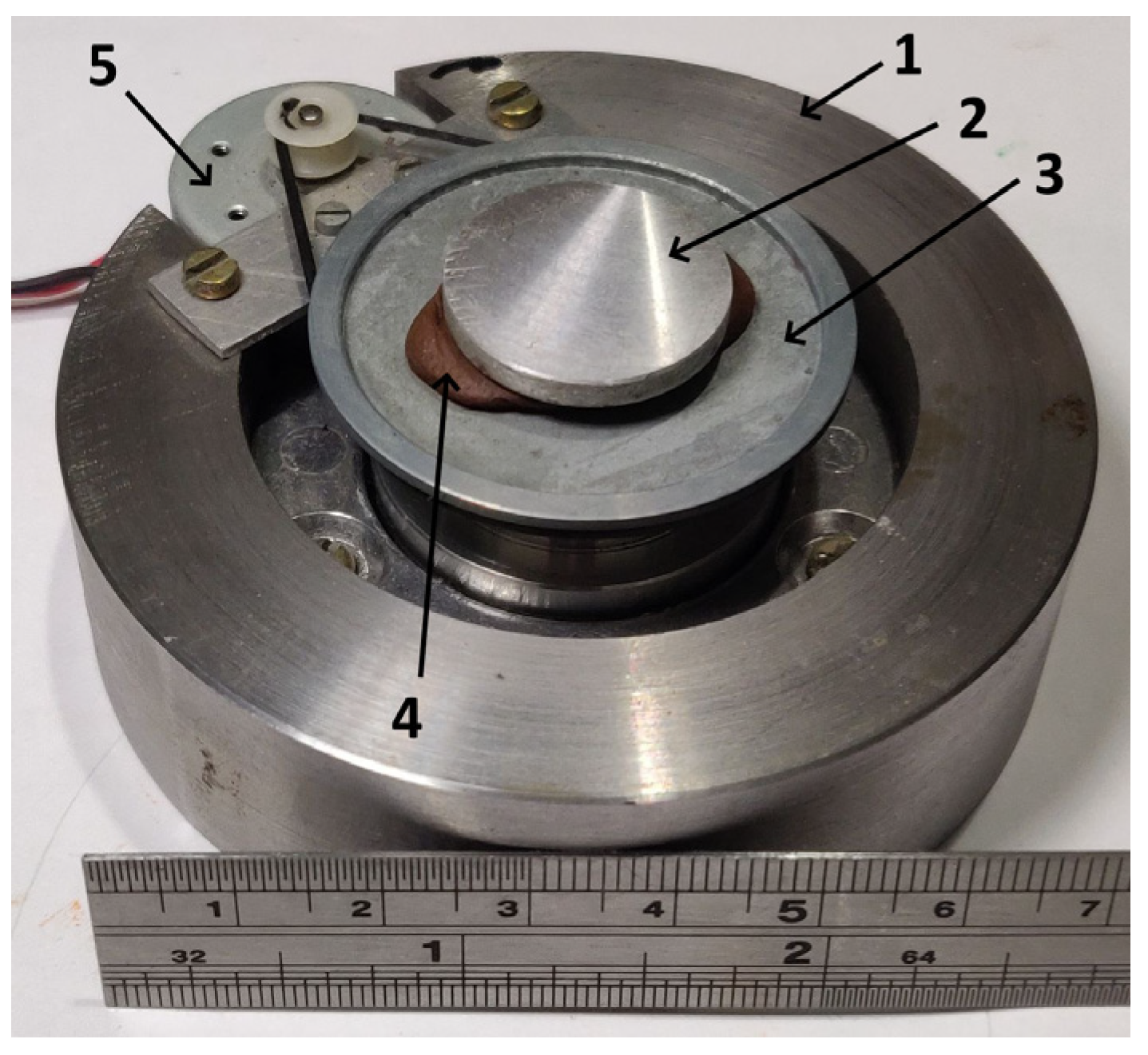


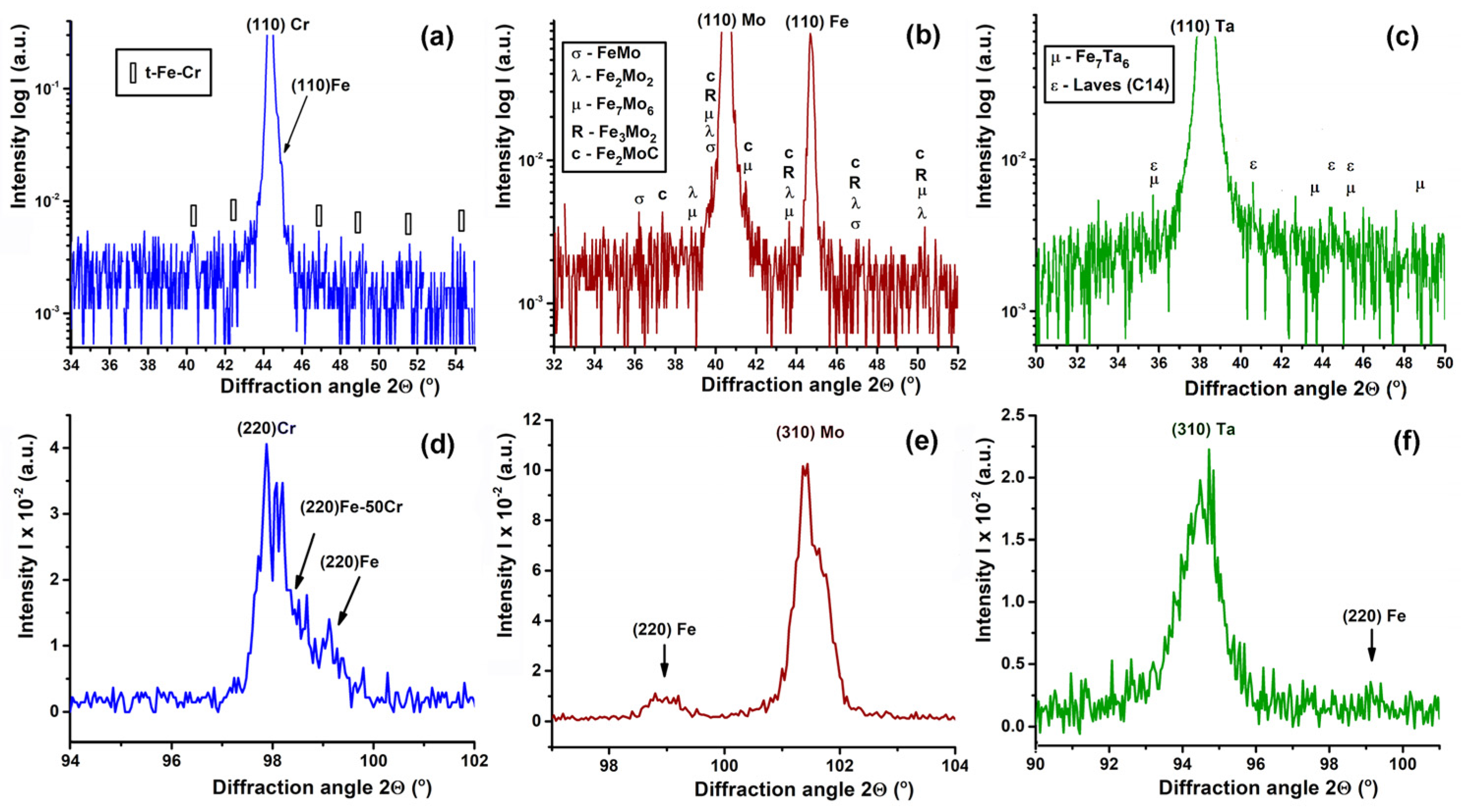
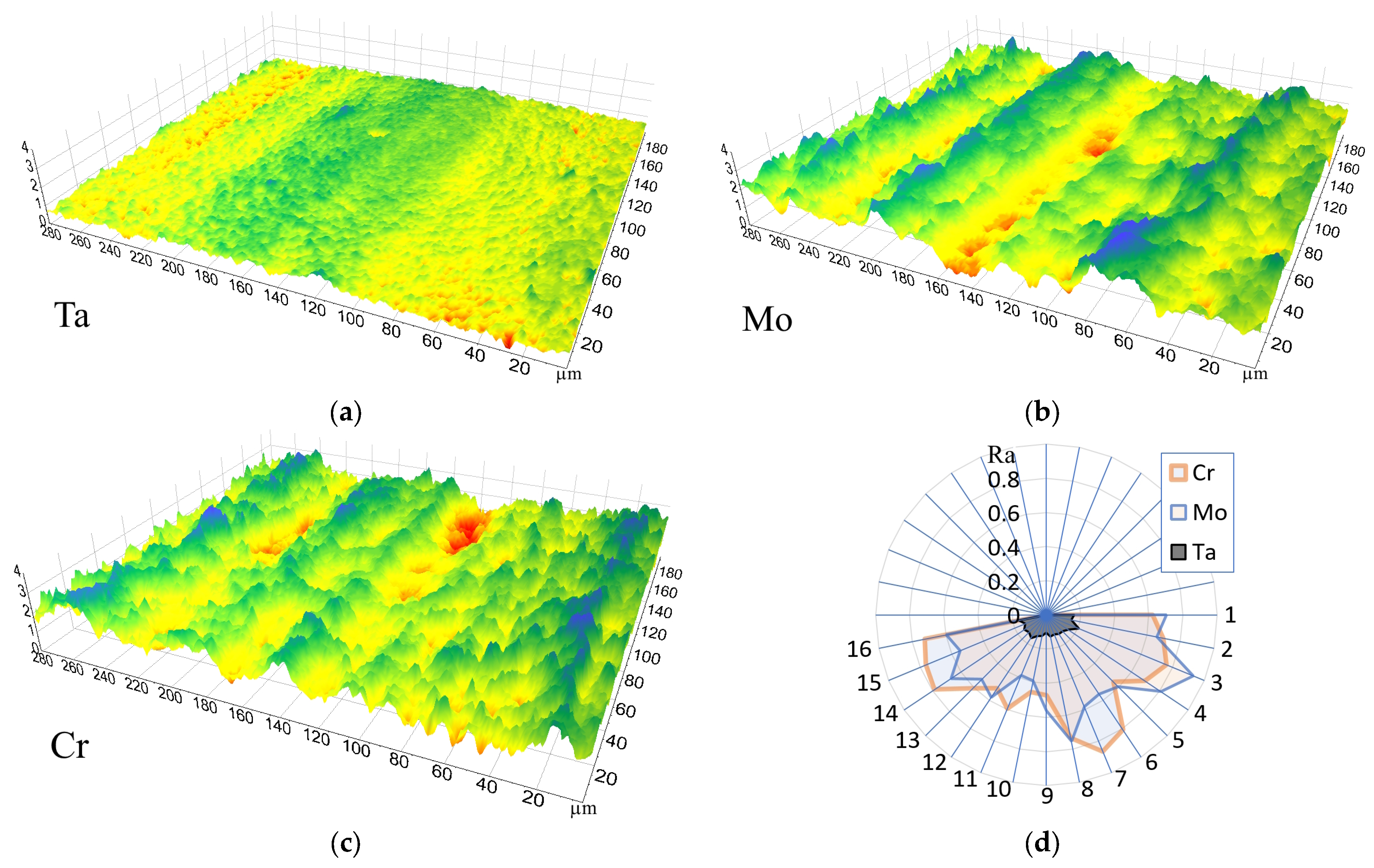
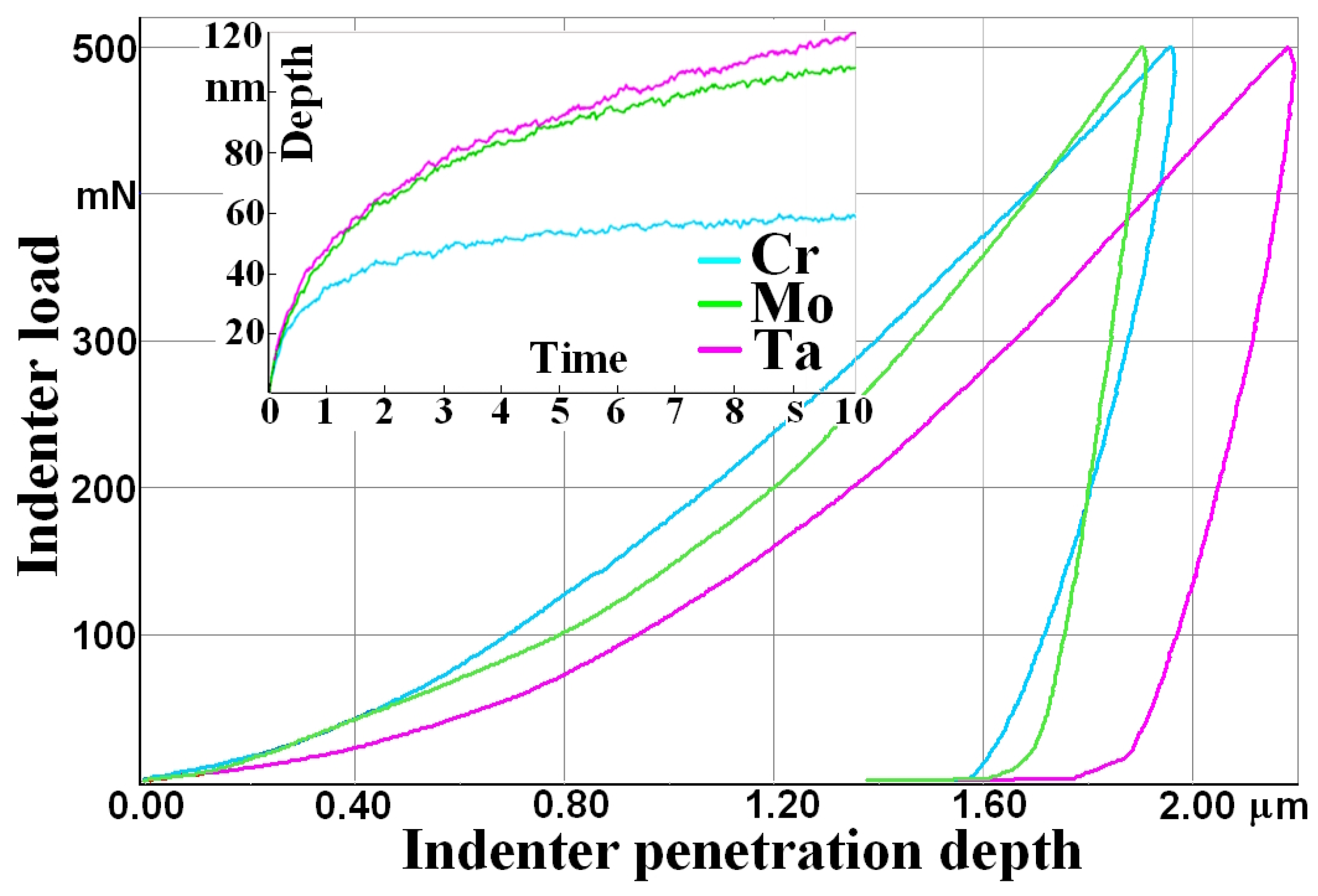
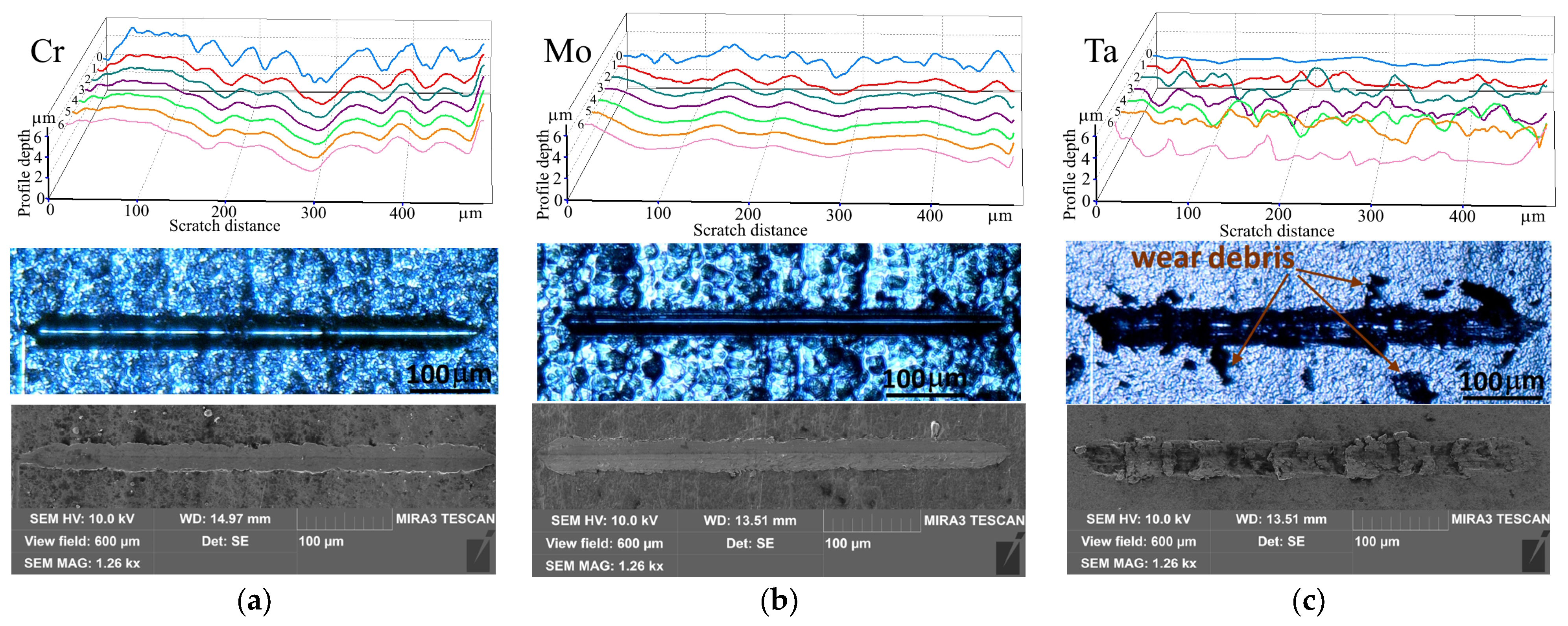

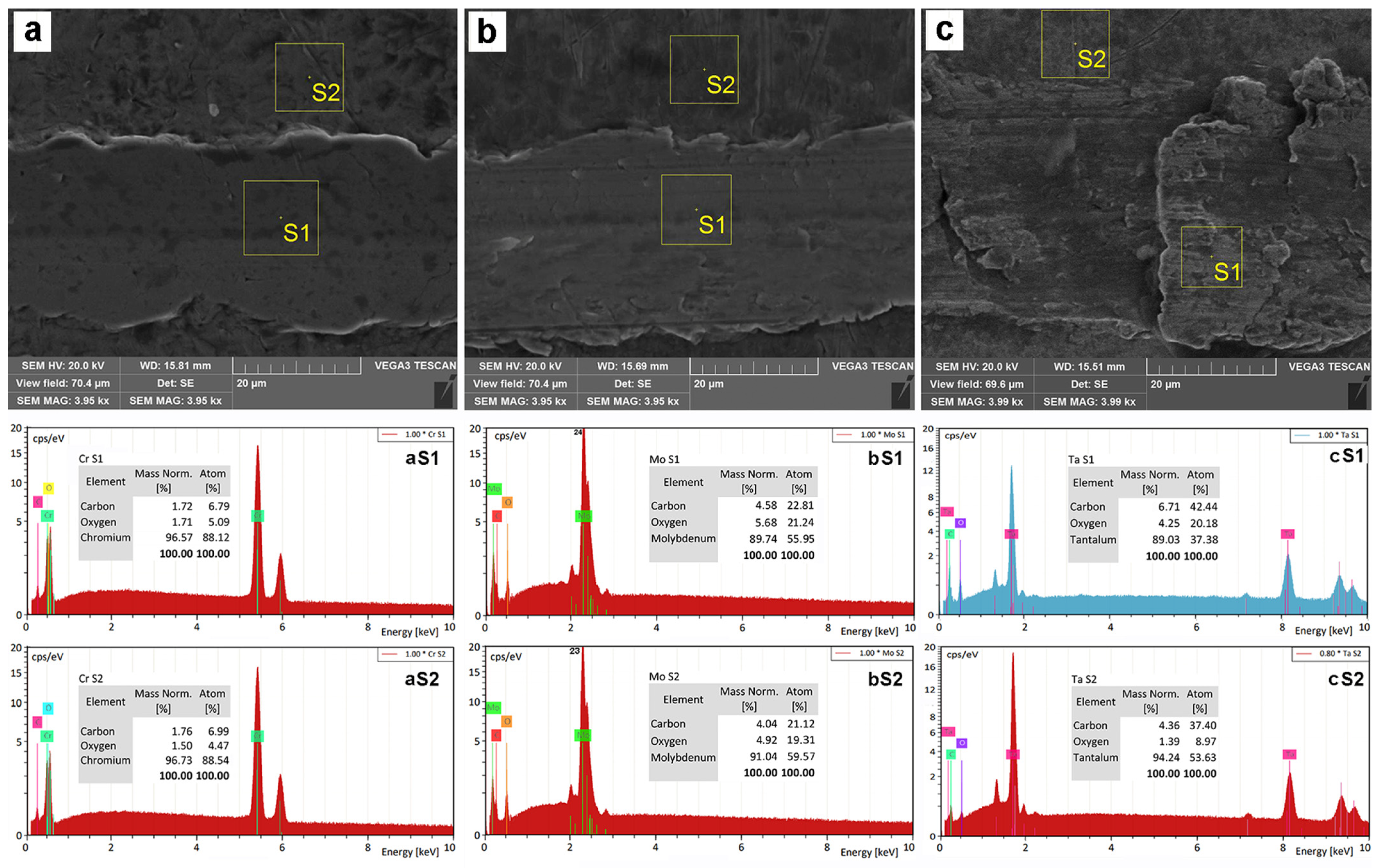
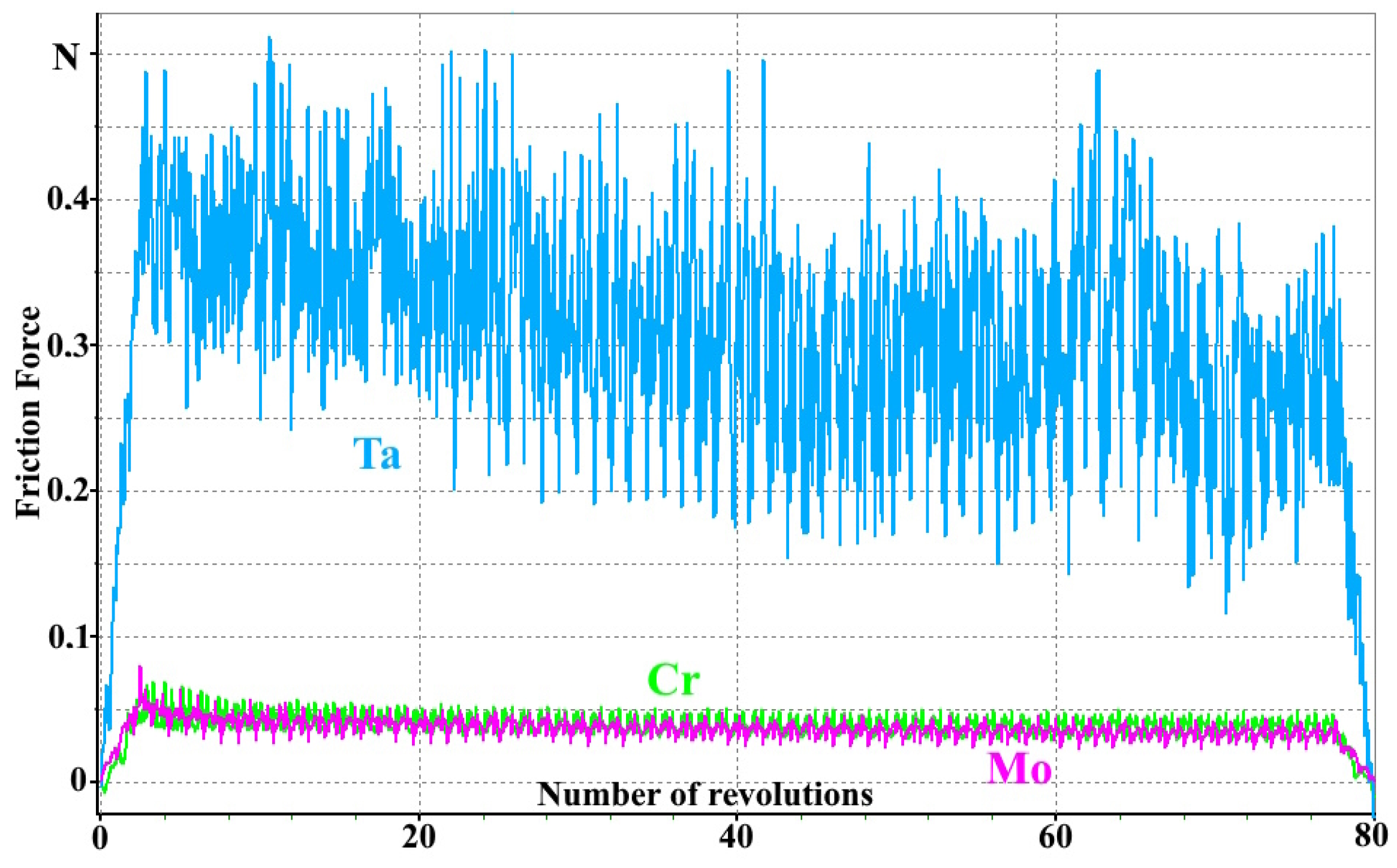
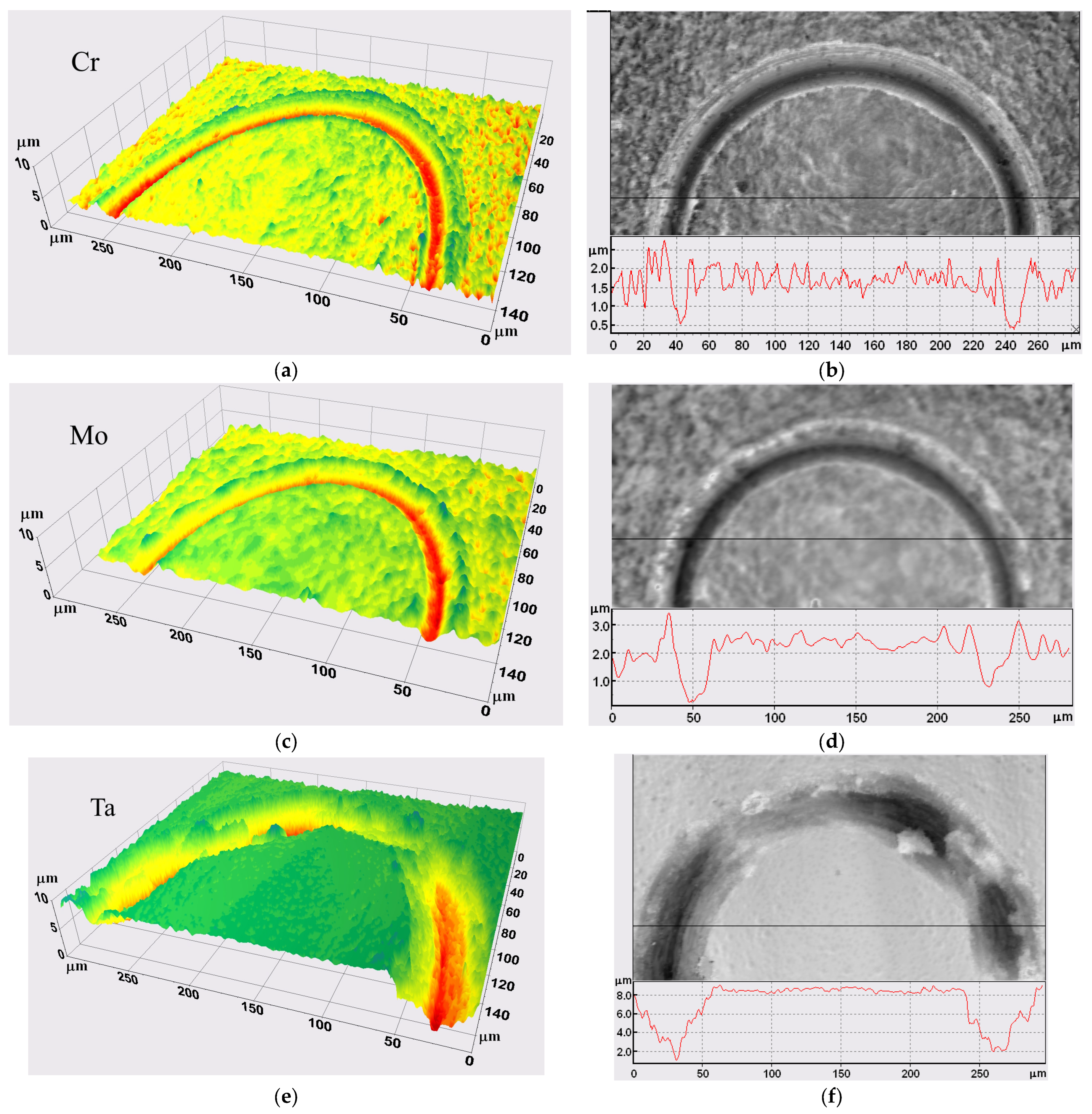
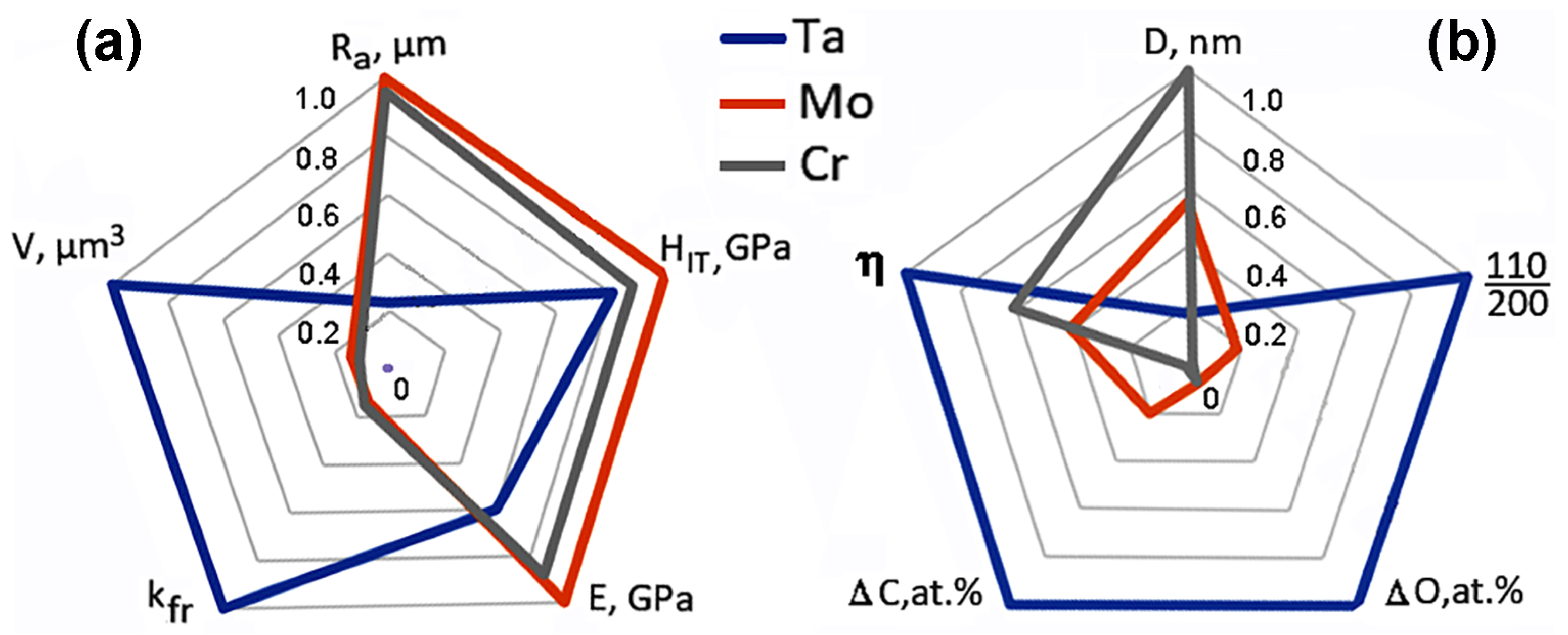
| Coating | HIT, GPa | E, GPa | Hs, GPa | kfr | kpl | Ra, μm | r0–6 | V, µm3 |
|---|---|---|---|---|---|---|---|---|
| Ta | 3.4 (2.8) | 171 (180) | - | 0.6 | - | 0.1 ÷ 0.2 | 0.14 | 172 × 106 |
| Mo | 4.2 (3.3) | 285 (320) | 4.3 | 0.08 | 0.11 | 0.4 ÷ 0.9 | 0.4 | 24 × 106 |
| Cr | 3.7 (2.0) | 250 (250) | 3.4 | 0.09 | 0.214 | 0.45 ÷ 0.8 | 0.85 | 19 × 106 |
Disclaimer/Publisher’s Note: The statements, opinions and data contained in all publications are solely those of the individual author(s) and contributor(s) and not of MDPI and/or the editor(s). MDPI and/or the editor(s) disclaim responsibility for any injury to people or property resulting from any ideas, methods, instructions or products referred to in the content. |
© 2025 by the authors. Licensee MDPI, Basel, Switzerland. This article is an open access article distributed under the terms and conditions of the Creative Commons Attribution (CC BY) license (https://creativecommons.org/licenses/by/4.0/).
Share and Cite
Zakiev, V.; Nadtoka, V.; Zakiev, I.; Mordyuk, B.; Yakushenko, O.; Trofimov, I.; Skoryk, M.; Yutskevych, S. Micromechanical Properties and Tribological Performance of Mo, Cr, and Ta Coatings Obtained by Cathodic Arc-Deposition. Coatings 2025, 15, 358. https://doi.org/10.3390/coatings15030358
Zakiev V, Nadtoka V, Zakiev I, Mordyuk B, Yakushenko O, Trofimov I, Skoryk M, Yutskevych S. Micromechanical Properties and Tribological Performance of Mo, Cr, and Ta Coatings Obtained by Cathodic Arc-Deposition. Coatings. 2025; 15(3):358. https://doi.org/10.3390/coatings15030358
Chicago/Turabian StyleZakiev, Vadim, Volodymyr Nadtoka, Islam Zakiev, Bohdan Mordyuk, Oleksandr Yakushenko, Igor Trofimov, Mykola Skoryk, and Sviatoslav Yutskevych. 2025. "Micromechanical Properties and Tribological Performance of Mo, Cr, and Ta Coatings Obtained by Cathodic Arc-Deposition" Coatings 15, no. 3: 358. https://doi.org/10.3390/coatings15030358
APA StyleZakiev, V., Nadtoka, V., Zakiev, I., Mordyuk, B., Yakushenko, O., Trofimov, I., Skoryk, M., & Yutskevych, S. (2025). Micromechanical Properties and Tribological Performance of Mo, Cr, and Ta Coatings Obtained by Cathodic Arc-Deposition. Coatings, 15(3), 358. https://doi.org/10.3390/coatings15030358







